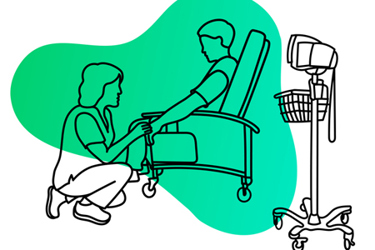From Protocol To People: Teva's Patient-First Clinical Trials Approach
By Eran Harary, MD, head of global early clinical development, Teva Pharmaceuticals

Now more than ever, patient centricity is an integral part of the clinical development process. While physician insights are valuable, directly engaging with the people whose lives are affected by a medical condition from the very beginning — patients, family members, caregivers, and advocates — can have a profound impact on clinical trial design, enrollment, data collection, study participants’ experience, and, most importantly, patient outcomes.
At Teva, this patient-focused mindset isn't just a trend; it's fundamental to how we develop therapies that we hope will be life-changing, and it stems from a culture of care.
Looking back on my almost 20 years in drug development, I'm struck by the sheer pace of progress and improvements to clinical studies for both researchers and participants. The processes we rely on today are vastly different from those of the past and are designed to drive greater efficiencies that accelerate the drug development process while simultaneously creating improved patient experiences and enhanced treatment outcomes.
An effective commitment to patient centricity is not a fragmented effort; it's a holistic approach that spans the end-to-end drug development process. At Teva, this means looking through this lens from the earliest cross-functional discussions to the ongoing monitoring and adaptation of our studies.
Teams across the organization, including representatives from clinical development, medical affairs, regulatory affairs, and clinical operations, regularly convene to discuss patient needs and concerns. A prime example is our drug development program for multiple system atrophy, where the needs of patients were at the heart of every stage — from the earliest phases of development, through the design of the clinical study, to its execution and operational planning. The study was carefully tailored to reflect what truly matters to patients, including the selection of meaningful outcome measures and the adaptation of research procedures to suit the specific challenges faced by individuals living with this debilitating condition. For example, for some patients, parameters such as mobility or other functional abilities are particularly important, and these are not always fully aligned with conventional questionnaires and conservative measurement methods. Therefore, we intentionally designed the trial to capture these specific parameters during data collection, enabling us to evaluate outcomes with consideration for these critical factors.
In addition to our internal partners, our external stakeholders are vital to our success, most notably our valued advocacy group partners whose insights ensure that we truly understand and address the full spectrum of patient needs. In one instance, our engagement with mental health advocacy partners confirmed a crucial point: Medication adherence is a major challenge for some patients. This helped us develop solutions focused on improving adherence and inform our clinical trial designs. Often, it’s advocacy organizations that raise their hands first and let us know about patient preferences or limitations, such as the optimum number of clinic visits per month. With a blend of scientific expertise, an extensive network, and a thoughtful, curious approach, our teams develop clinical trials that drive bold discoveries and accelerate innovation with a strong focus on patient needs.
We do more than simply analyze patient behavior; we actively seek to understand patients’ lived experiences. For example, by gathering feedback from a particular patient population that struggles to take oral medications, we proactively explored alternative delivery methods, such as injections and long-acting treatments, to improve adherence and overall outcomes. This approach is what led us to the development of a subcutaneous long-acting injectable therapy of one of the most prescribed medications for schizophrenia.
By truly listening to and understanding patients’ priorities, we can ensure that everything is carefully tailored to meet the specific needs of particular patient populations. For example, when designing a schizophrenia trial, our team will make sure that all aspects of the trial, including the logistical processes, the sequence of interactions with the patient during their clinic study visit, the resources available to the clinic staff, and the overall framework of the study, are built with those patients in mind. As a result, more trials offer remote visits and flexible scheduling, while also incorporating assessments of key patient-centered outcomes such as quality of life, social functioning, and treatment satisfaction.
Our goal is to serve patients with them incurring the least burden possible. As a researcher, it’s my nature to want to gather as much data as possible while working on clinical studies, and many scientists would likely agree that it’s one of the most rewarding aspects of our job. But data collection can be burdensome for participants and inefficient for researchers, so striking this balance between data generation and ensuring maximum ease for patients has become an art in itself — one at which we are becoming more skilled.
For instance, only a few years ago, we were using patient-completed questionnaires to collect data. But relying on their memory introduced biases into our data and created extra work for patients. Similarly, requiring patients to constantly fill out questionnaires or come into the clinic multiple times a week was unsustainable, especially for people with mobility-related challenges.
Now, technological advances have revolutionized data collection. Sensors, wearable devices, and remote applications allow us to collect valid and accurate data remotely and more quickly than ever before. In the years, maybe months, to come, this technology stands poised to transform our data capture further, perhaps enabling individualized trial protocols and richer, deeper data than we would have dreamed possible even five years ago.
Many times, we plan for "interim looks," in which we pause to analyze the data collected at predefined intervals and assess the patient experience thus far. This allows us to proactively reshape the study based on our findings, ensuring that we're continuously optimizing the trial for the benefit of the patients involved. Naturally, any modifications are made in close consultation with regulatory bodies such as the FDA, ensuring that the study's integrity and validity are maintained. Going forward, we may be able to do these “interim looks” more regularly and pivot more quickly.
From the earliest stages of trial design to the final data analysis, my colleagues and I are focused on understanding and addressing the needs of the patients we serve. We're constantly thinking about how we can best prioritize the patient experience. How do we make sure patients are comfortable? How do we address their needs? How do we ensure their feedback is incorporated seamlessly into the process? Even Teva’s senior executives get involved in the details, testing equipment to ensure it meets the highest standards of comfort.
Patient care is the bedrock upon which Teva is built and the thread that connects every function of the business. I’m optimistic that tomorrow’s clinical trials will be easier for patients, quicker to produce results, and lead to greater advances in therapies for people everywhere.
About The Author:
 Eran Harary, MD, head of global early clinical development at Teva Pharmaceuticals, is a leader with a track record in the comprehensive life cycle management of pharmaceuticals, encompassing both small molecules and biologics. His expertise spans the entire journey from initial concept through all development stages, culminating in successful reimbursement, commercialization, and marketing.
Eran Harary, MD, head of global early clinical development at Teva Pharmaceuticals, is a leader with a track record in the comprehensive life cycle management of pharmaceuticals, encompassing both small molecules and biologics. His expertise spans the entire journey from initial concept through all development stages, culminating in successful reimbursement, commercialization, and marketing.
As a medical doctor specializing in psychiatry, Dr. Harary brings two decades of senior leadership experience in both clinical and commercial operations. Driven by a passion for medicine, drug development, and innovation, he champions creative thinking, particularly in neuroscience, mental health, and advanced technologies. His dedication to people and well-being underpins a patient-centric approach.
